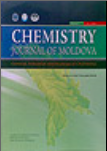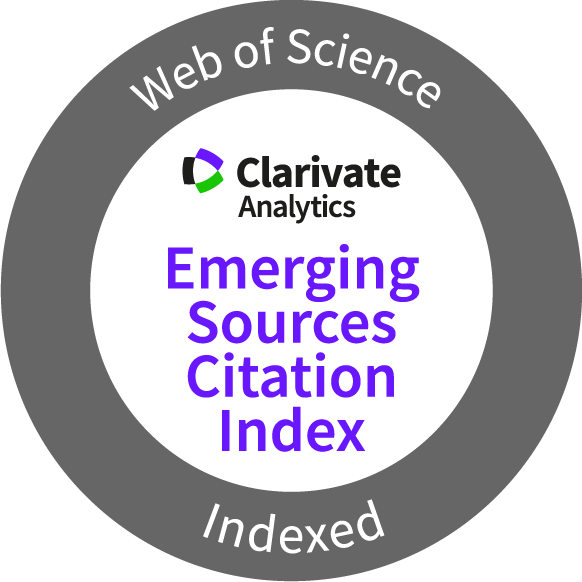Chemistry Journal of Moldova
2024 Volume 19, no.1
COVER
INDEXING
EDITORIAL_BOARD
ISSUE CONTENTS LIST WITH GRAPHICAL ABSTRACTS
EDITORIAL
INSTRUCTIONS FOR AUTHORS
INDEXING
EDITORIAL_BOARD
ISSUE CONTENTS LIST WITH GRAPHICAL ABSTRACTS
EDITORIAL
INSTRUCTIONS FOR AUTHORS
Author(s):
Field: Physical chemistry and chemical physics
Type: Research paper
Issue: 2024 Volume 19, no.1
Pages: 93-101
Oleg Petuhov, Nina Timbaliuc, Irina Ceban (Ginsari), Silvia Cibotaru, Tudor Lupascu, Raisa Nastas
Field: Physical chemistry and chemical physics
Type: Research paper
Issue: 2024 Volume 19, no.1
Pages: 93-101
Full Text (PDF): Download
https://doi.org/10.19261/cjm.2024.897
Abstract (PDF)
Supplementary Material (PDF)
Graphycal Abstract: The purpose of this work was to compare the structural and sorption characteristics of local vegetal activated carbon obtained from apricot stones (AC-C, Republic of Moldova) with that of commercial activated carbons (Granucol® BI/GE/FA, Germany). According to the obtained results, the local vegetal activated carbon (AC-C) has proven to be comparatively effective with commercial ones (Granucol® type) in removing methylene blue dye from solutions.

Downloads: 276
Author(s):
Field: Physical chemistry and chemical physics
Type: Research paper
Issue: 2024 Volume 19, no.1
Pages: 84-92
Zainab Jasim Khudair and Zeina Mohammad Kadam
Field: Physical chemistry and chemical physics
Type: Research paper
Issue: 2024 Volume 19, no.1
Pages: 84-92
Full Text (PDF): Download
https://doi.org/10.19261/cjm.2024.1161
Abstract (PDF)
Supplementary Material (PDF)
Graphical Abstract: A nanocomposite of chitosan and poly acrylic acid grafting multi-walled carbon nanotubesp (CS-co-AA)/MWCNTs was applied as adsorbent for Ofloxacin adsorption from water solutions. The isotherm constant (KF) of 0.218 and the separation factor (R2) of 0.956 indicate a strong and desirable adsorption of OFL on p(CS-co-AA)/MWCNTs with a concentration of 100 mg/L at a temperature of 293K and an acidic medium with pH of 7.0.
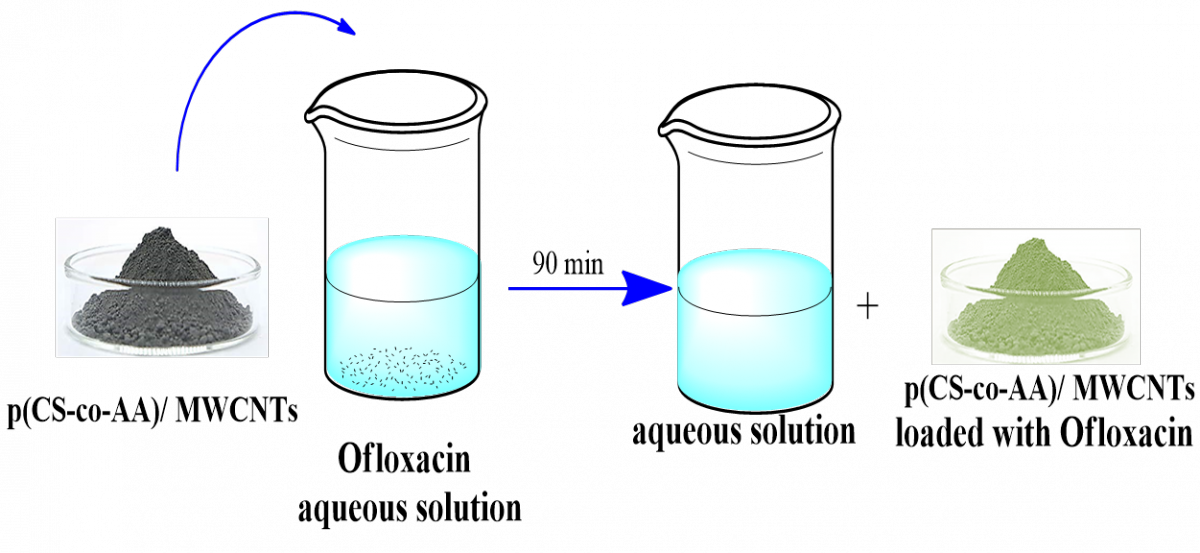
Downloads: 183
Author(s):
Field: Analytical chemistry
Type: Research paper
Issue: 2024 Volume 19, no.1
Pages: 37-46
Abdelghani Mahmoudi and Ann Van Schepdael
Field: Analytical chemistry
Type: Research paper
Issue: 2024 Volume 19, no.1
Pages: 37-46
Full Text (PDF): Download
https://doi.org/10.19261/cjm.2024.1165
Graphical Abstract: The developed spectrophotometric methods were based on charge transfer reactions of naphthoquinones with Josamycin. Methods validity was tested and the results were in accordance with ICH guidelines. Procedures showed successful adaptability for an easy analysis of this macrolide in various dosage forms and can be used for quality control purposes.
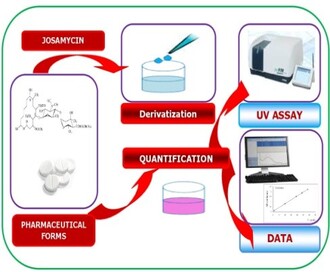
Downloads: 596
Author(s):
Field: Physical chemistry and chemical physics
Type: Research paper
Issue: 2024 Volume 19, no.1
Pages: 102-111
Sri Wuryanti, Tina Mulya Gantina, Annisa Syafitri Kurniasetiawati
Field: Physical chemistry and chemical physics
Type: Research paper
Issue: 2024 Volume 19, no.1
Pages: 102-111
Full Text (PDF): Download
https://doi.org/10.19261/cjm.2024.1157
Abstract (PDF)
Supplementary Material (PDF)
Graphical Abstract: This research systematically investigates the impact of porphyrin and chlorophyll dyes derived from Syzygium Paniculatum on Dye-Sensitized Solar Cells (DSSC) performance, aiming to achieve maximum solar cell efficiency. The investigation involves utilizing fluorine-doped tin oxide coating with a TiO2-ZnO composite. Results demonstrate that DSSCs based on TiO2-ZnO: Al + chlorophyll produce an efficiency of 13.32%, while porphyrin (2:2:0.1) and (2:2:0.2) produce efficiencies of 8.91% and 13.95%, respectively. These findings highlight the potential of utilizing natural dyes for enhancing DSSC performance.
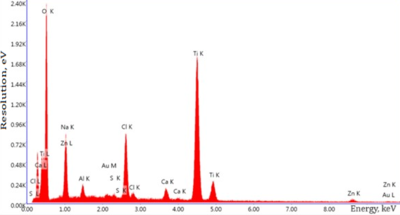
Downloads: 110
Author(s):
Field: Analytical chemistry
Type: Research paper
Issue: 2024 Volume 19, no.1
Pages: 29-36
Crina Vicol, Alexandra Sârghi, Adrian Fifere, Gheorghe Duca
Field: Analytical chemistry
Type: Research paper
Issue: 2024 Volume 19, no.1
Pages: 29-36
Full Text (PDF): Download
https://doi.org/10.19261/cjm.2024.1190
Abstract (PDF)
Graphical Abstract: The study presents data on the antioxidant interaction between ascorbic and dihydroxyfumaric acids determined via DPPH method, by applying EPR spectroscopy. The type of antioxidant interaction is dependent on the concentration ratio of the ascorbic and dihydroxyfumaric acids, thus, at the mM DHF/mM AA ratios of 1.4 and 1.7 the highest synergistic effects of 1.24 have been noticed, but at the mM DHF/mM AA ratio of 1 – an antagonistic effect of 0.93 was registered.
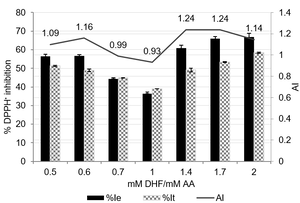
Downloads: 97
Author(s):
Field: Inorganic and coordination chemistry
Type: Research paper
Issue: 2024 Volume 19, no.1
Pages: 62-68
Viorina Gorinchoy, Olesea Cuzan, Sergiu Shova, Vasile Lozan
Field: Inorganic and coordination chemistry
Type: Research paper
Issue: 2024 Volume 19, no.1
Pages: 62-68
Full Text (PDF): Download
https://doi.org/10.19261/cjm.2024.1168
Abstract (PDF)
Graphical Abstract: A new heterometallic iron(III) compound, derivative of salicylic acid, catena–poly[bis(methanol)-bis(N,N–dimethylacetamide)–tris(m–salicylato)–bis(m–salicyl)–dicalcium(II) iron(III)], has been synthesized and characterized by infrared spectroscopy, single-crystal X-ray diffraction and elemental analysis. Single-crystal X-ray diffraction study revealed that synthesized compound forms an 1D coordination polymer with general formula {[FeCa2(Sal)2(SalH)3 (DMA)2(CH3OH)2]}n. The compound crystallizes in the P21/c space group of the monoclinic system with the following unit cell parameters: а= 9.76785(9), b= 37.3386(4), c= 13.82575(12) Å, β= 103.6421(9)°, Z= 4. The independent unit cell of the obtained compound contains one iron and two calcium ions, in which the iron(III) ion has an octahedral coordination sphere. The different coordination modes of the five molecules of salicylic anions revealed by IR analysis were confirmed by X-ray studies, showing that the salicylate anions play the role of bridging ligands and coordinate in three different ways, thus the carboxylic group forms bridges through three different coordination pathways, namely: bidentate, tridentate and pentadentate fashion.

Downloads: 109
Author(s):
Field: Ecological chemistry
Type: Research paper
Issue: 2024 Volume 19, no.1
Pages: 56-61
Kaltrina Jusufi, Enju Wang, Taha Fadlou Allah, Ali A. Shohatee, Sudhir Kumar Singh, Makfire Sadiku
Field: Ecological chemistry
Type: Research paper
Issue: 2024 Volume 19, no.1
Pages: 56-61
Full Text (PDF): Download
https://doi.org/10.19261/cjm.2024.1144
Abstract (PDF)
Graphical Abstract: This study examines the potential use of a low-cost biosorbent - chamomile tea residues, as an alternative to traditional adsorbents for removing Pb2+ ions from aqueous solutions. The results show that lead concentration is reduced under optimized conditions, achieving an impressive nearly 50% Pb2+ ions removal with a mere just 0.05 g of the waste material, depicting chamomile tea residues as efficient biosorbent in lead removal.
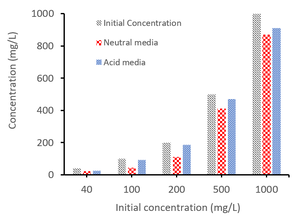
Downloads: 107
Author(s):
Field: Organic chemistry
Type: Research paper
Issue: 2024 Volume 19, no.1
Pages: 76-83
Nuzhat Rehman, Ayaz Mahmood Dar, Raja Feroz Ahmad Haji, Sharief-ud-din Khan, Deepak Pareek, Saleem Farooq, Bashir Ahmad Dar
Field: Organic chemistry
Type: Research paper
Issue: 2024 Volume 19, no.1
Pages: 76-83
Full Text (PDF): Download
https://doi.org/10.19261/cjm.2024.1135
Abstract (PDF)
Supplementary Material (PDF)
Graphical Abstract: This study presents an eco-friendly method for synthesizing 3,4-dihydropyrimidin-2(1H)-ones (DHPMs) through the Biginelli reaction. A novel Heteropolyacid-Clay (HPA-Clay) catalyst, formed by immobilizing H5PV2W10O40 on Montmorillonite KSF clay, displays enhanced stability and catalytic efficiency. Operating under solvent-free, one-pot conditions, the process delivers DHPMs with high yields and shortened reaction times. Catalyzed by 2 mol% HPA-Clay, it adheres to green chemistry principles, emphasizing cost-efficiency, environmental sustainability, and recyclability. The catalyst consistently performs over multiple cycles, showcasing promise for advancing Biginelli reactions.

Abstract (PDF)
Supplementary Material (PDF)
Graphical Abstract: This study presents an eco-friendly method for synthesizing 3,4-dihydropyrimidin-2(1H)-ones (DHPMs) through the Biginelli reaction. A novel Heteropolyacid-Clay (HPA-Clay) catalyst, formed by immobilizing H5PV2W10O40 on Montmorillonite KSF clay, displays enhanced stability and catalytic efficiency. Operating under solvent-free, one-pot conditions, the process delivers DHPMs with high yields and shortened reaction times. Catalyzed by 2 mol% HPA-Clay, it adheres to green chemistry principles, emphasizing cost-efficiency, environmental sustainability, and recyclability. The catalyst consistently performs over multiple cycles, showcasing promise for advancing Biginelli reactions.

Downloads: 91
Author(s):
Field: Ecological chemistry
Type: Research paper
Issue: 2024 Volume 19, no.1
Pages: 47-55
Recep Taş, Ebru Köroğlu, Ahmet Karakuş, Ali Savaş Bülbül, Nilay Akkuş Taş
Field: Ecological chemistry
Type: Research paper
Issue: 2024 Volume 19, no.1
Pages: 47-55
Full Text (PDF): Download
https://doi.org/10.19261/cjm.2024.1113
Abstract (PDF)
Graphical Abstract: This study explores the green synthesis of silver and zinc nanoparticles using Laurel extract as a reducing agent. The biosynthesized nanoparticles were characterized for size, shape, and structure. Photocatalytic activities were evaluated for potential environmental applications. Results show promising prospects for sustainable nanoparticle synthesis and efficient photocatalytic degradation.

Downloads: 754
Author(s):
Field: Natural product chemistry and synthesis
Type: Research paper
Issue: 2024 Volume 19, no.1
Pages: 69-75
Alexandru Ciocarlan, Lidia Lungu, Svetlana Blaja, Sergiu Shova, Aculina Aricu
Field: Natural product chemistry and synthesis
Type: Research paper
Issue: 2024 Volume 19, no.1
Pages: 69-75
Full Text (PDF): Download
https://doi.org/10.19261/cjm.2024.1156
Abstract (PDF)
Supplementary Material (PDF)
Graphical Abstract: The main purpose of this research was the synthesis of highly functionalized derivatives of (+)-larixol by combination of classical and nonconventional method, like dye-sensitized photooxidation with preservation of outside chain. As a result, a series of four new cycle B derivatives of (+)-larixol were obtained. The structure of all synthesized compounds was fully confirmed by spectral method (IR, 1H and 13C NMR) and for compound containing endoperoxide functional group, additionally by single crystal X-ray diffraction analysis.
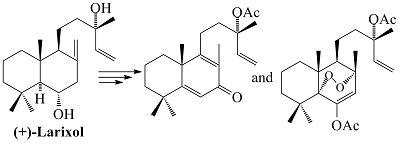
Downloads: 81
